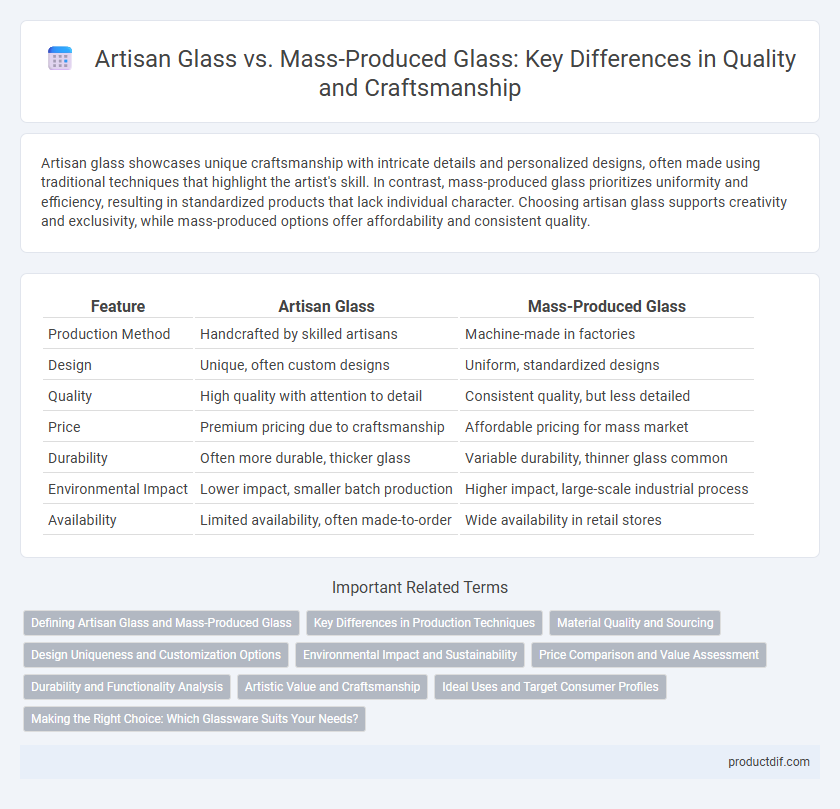Artisan glass showcases unique craftsmanship with intricate details and personalized designs, often made using traditional techniques that highlight the artist's skill. In contrast, mass-produced glass prioritizes uniformity and efficiency, resulting in standardized products that lack individual character. Choosing artisan glass supports creativity and exclusivity, while mass-produced options offer affordability and consistent quality.
Table of Comparison
| Feature | Artisan Glass | Mass-Produced Glass |
|---|---|---|
| Production Method | Handcrafted by skilled artisans | Machine-made in factories |
| Design | Unique, often custom designs | Uniform, standardized designs |
| Quality | High quality with attention to detail | Consistent quality, but less detailed |
| Price | Premium pricing due to craftsmanship | Affordable pricing for mass market |
| Durability | Often more durable, thicker glass | Variable durability, thinner glass common |
| Environmental Impact | Lower impact, smaller batch production | Higher impact, large-scale industrial process |
| Availability | Limited availability, often made-to-order | Wide availability in retail stores |
Defining Artisan Glass and Mass-Produced Glass
Artisan glass is handcrafted by skilled artisans using traditional techniques, resulting in unique, high-quality pieces with individual character and intricate details. Mass-produced glass is manufactured using automated processes, allowing for large quantities of uniform products with consistent shapes and patterns at lower costs. The distinction lies in the level of craftsmanship, customization, and production scale.
Key Differences in Production Techniques
Artisan glass is handcrafted using traditional techniques such as blowing, shaping, and molding, which allow for unique designs and intricate details tailored by skilled craftsmen. Mass-produced glass is created through automated processes like pressing and machine forming, enabling consistent shapes and high-volume output with less individual variation. The key difference lies in the level of manual craftsmanship versus mechanized efficiency, impacting the final product's uniqueness and quality.
Material Quality and Sourcing
Artisan glass is crafted using high-quality, carefully sourced materials, often including premium silica sand and natural fluxes, ensuring superior clarity and durability. Mass-produced glass typically relies on standardized, industrial-grade raw materials, resulting in more uniform but less refined finishes. The emphasis on selective sourcing in artisan glass contributes to unique visual textures and enhanced strength compared to mass-produced alternatives.
Design Uniqueness and Customization Options
Artisan glass showcases unparalleled design uniqueness, with each piece reflecting the individual craftsmanship and creativity of the glassblower, resulting in one-of-a-kind patterns and textures. Customization options in artisan glass include personalized shapes, colors, and engravings tailored to client specifications, unlike mass-produced glass which relies on standardized molds and limited designs. This handcrafted approach ensures that artisan glassware serves not only as functional items but also as artistic expressions and collectible objects.
Environmental Impact and Sustainability
Artisan glass production utilizes traditional techniques that often result in lower energy consumption and reduced carbon emissions compared to mass-produced glass manufacturing, which relies heavily on high-temperature industrial furnaces and automated processes. Small-batch artisan glassmakers frequently incorporate recycled materials and prioritize sustainable sourcing, minimizing environmental footprint and waste generation. In contrast, mass-produced glass manufacturing typically generates a higher volume of industrial waste and demands significant raw material extraction, impacting resource depletion and ecosystems.
Price Comparison and Value Assessment
Artisan glass typically commands higher prices due to its handcrafted nature, unique designs, and limited production, reflecting superior craftsmanship and exclusivity. In contrast, mass-produced glass offers affordability and accessibility but often lacks the distinctiveness and quality found in artisan pieces. The value assessment favors artisan glass for collectors and enthusiasts seeking originality and durability, while mass-produced glass suits everyday use where cost efficiency is prioritized.
Durability and Functionality Analysis
Artisan glass typically boasts superior durability due to meticulous craftsmanship and the use of high-quality materials, resulting in resistance to chipping and thermal stress. Mass-produced glass often sacrifices strength for cost efficiency, leading to thinner walls and higher susceptibility to breakage during everyday use. Functionality in artisan glass is enhanced by tailored design features that improve grip and usability, whereas mass-produced glass emphasizes uniformity and volume output over ergonomic considerations.
Artistic Value and Craftsmanship
Artisan glass exemplifies exceptional artistic value, showcasing unique designs crafted through meticulous handwork and traditional techniques that emphasize individual creativity and skill. In contrast, mass-produced glass prioritizes uniformity and efficiency, often resulting in less intricate detail and diminished craftsmanship quality. The distinctive character and nuanced imperfections in artisan glass reflect the artisan's expertise, making each piece a collectible work of art.
Ideal Uses and Target Consumer Profiles
Artisan glass offers unique designs and superior craftsmanship ideal for collectors, high-end decor, and personalized gifts, appealing to consumers seeking exclusivity and artistic value. Mass-produced glass provides consistency, affordability, and durability, fitting everyday use in households, restaurants, and commercial settings targeting budget-conscious buyers. Each type serves distinct purposes, with artisan pieces enhancing aesthetic appeal and mass-produced options meeting practical, large-volume demands.
Making the Right Choice: Which Glassware Suits Your Needs?
Artisan glass offers unique craftsmanship and intricate designs, ideal for those valuing individuality and high-quality materials, while mass-produced glass provides affordability and uniformity suited for everyday use. Choosing the right glassware depends on intended use, budget, and aesthetic preferences, with artisan pieces enhancing special occasions and mass-produced options excelling in durability and practicality. Consider factors like material quality, production method, and design complexity when selecting glassware that best complements your lifestyle.
Artisan glass vs mass-produced glass Infographic

 productdif.com
productdif.com